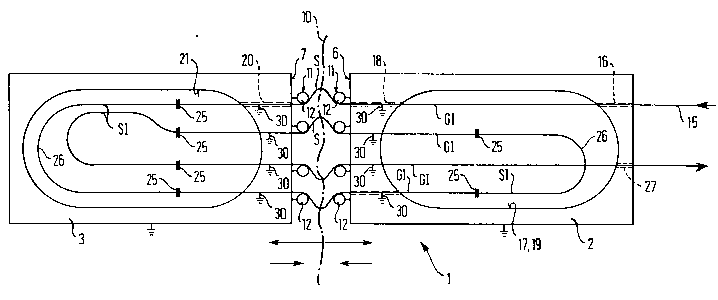Some of the information on this Web page has been provided by external sources. The Government of Canada is not responsible for the accuracy, reliability or currency of the information supplied by external sources. Users wishing to rely upon this information should consult directly with the source of the information. Content provided by external sources is not subject to official languages, privacy and accessibility requirements.
Any discrepancies in the text and image of the Claims and Abstract are due to differing posting times. Text of the Claims and Abstract are posted:
| (12) Patent Application: | (11) CA 2135723 |
|---|---|
| (54) English Title: | MEASURING SYSTEM FOR MONITORING BUILDINGS, TERRAIN SECTIONS OR THE LIKE |
| (54) French Title: | SYSTEME DE MESURE POUR LA SURVEILLANCE DE BATIMENTS, DE TERRAINS ET AUTRES ESPACES ANALOGUES |
| Status: | Deemed Abandoned and Beyond the Period of Reinstatement - Pending Response to Notice of Disregarded Communication |
| (51) International Patent Classification (IPC): |
|
|---|---|
| (72) Inventors : |
|
| (73) Owners : |
|
| (71) Applicants : |
|
| (74) Agent: | SMART & BIGGAR LP |
| (74) Associate agent: | |
| (45) Issued: | |
| (22) Filed Date: | 1994-11-14 |
| (41) Open to Public Inspection: | 1996-05-15 |
| Availability of licence: | N/A |
| Dedicated to the Public: | N/A |
| (25) Language of filing: | English |
| Patent Cooperation Treaty (PCT): | No |
|---|
| (30) Application Priority Data: | None |
|---|
The measuring system for monitoring buildings, terrain
sections or the like consists of a beam waveguide bending sensor
which has a multimode beam waveguide (GI) and is disposed in the
shape of a loop. Several arc-shaped sensor sections (S) are
disposed between support plates, which are movable in respect to
the sensor sections and and fixedly connected with areas of the
building or terrain sections. A light source and light receiver
with an evaluation device for light subduing values are connected
to the beam waveguide bending sensor. The beam waveguide bending
sensor is disposed in the form of several loops. The beam
waveguide bending sensor consists of gradient-index-multimode beam
waveguide sections (GI) and step-index-multimode beam waveguide
sections (SI) connected therewith, wherein the sensor sections (S)
are formed by the gradient-index-multimode beam waveguide (GI).
Note: Claims are shown in the official language in which they were submitted.
Note: Descriptions are shown in the official language in which they were submitted.

2024-08-01:As part of the Next Generation Patents (NGP) transition, the Canadian Patents Database (CPD) now contains a more detailed Event History, which replicates the Event Log of our new back-office solution.
Please note that "Inactive:" events refers to events no longer in use in our new back-office solution.
For a clearer understanding of the status of the application/patent presented on this page, the site Disclaimer , as well as the definitions for Patent , Event History , Maintenance Fee and Payment History should be consulted.
| Description | Date |
|---|---|
| Inactive: IPC from MCD | 2006-03-11 |
| Inactive: IPC from MCD | 2006-03-11 |
| Inactive: IPC from MCD | 2006-03-11 |
| Time Limit for Reversal Expired | 1999-11-15 |
| Application Not Reinstated by Deadline | 1999-11-15 |
| Deemed Abandoned - Failure to Respond to Maintenance Fee Notice | 1998-11-16 |
| Letter Sent | 1998-02-24 |
| Reinstatement Requirements Deemed Compliant for All Abandonment Reasons | 1998-02-17 |
| Deemed Abandoned - Failure to Respond to Maintenance Fee Notice | 1997-11-14 |
| Application Published (Open to Public Inspection) | 1996-05-15 |
| Abandonment Date | Reason | Reinstatement Date |
|---|---|---|
| 1998-11-16 | ||
| 1997-11-14 |
The last payment was received on 1998-02-17
Note : If the full payment has not been received on or before the date indicated, a further fee may be required which may be one of the following
Please refer to the CIPO Patent Fees web page to see all current fee amounts.
| Fee Type | Anniversary Year | Due Date | Paid Date |
|---|---|---|---|
| Reinstatement | 1998-02-17 | ||
| MF (application, 3rd anniv.) - small | 03 | 1997-11-14 | 1998-02-17 |
Note: Records showing the ownership history in alphabetical order.
| Current Owners on Record |
|---|
| SICOM GESELLSCHAFT FUR SENSOR- UND VORSPANNTECHNIK MBH |
| Past Owners on Record |
|---|
| RAINER LEßING |